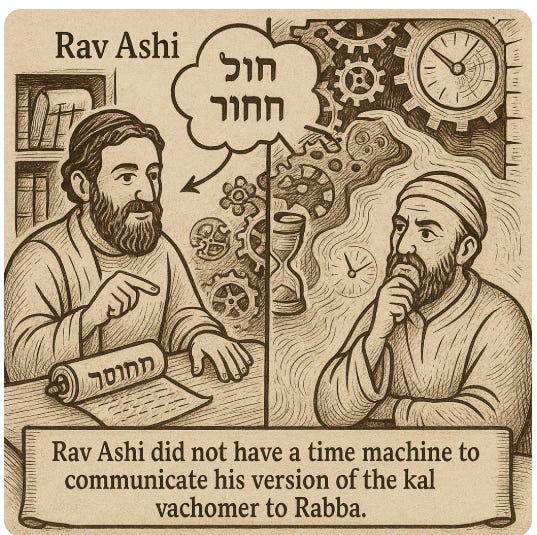Rav Ashi steps out of Time
In the last post, I kvetched a bit about megadef bah R’ Abahu, and how it doesn’t have its usual meaning. Truth be told, I’m bothered by several of the takes that the Talmudic Narrator has been offering in Zevachim, and I wonder if it is a different Talmudic Narrator than elsewhere. I’ll pen a series of posts where it is just me kvetching…
I gave the daf shiur on the second day of Rosh Hashanah, and something seemed rather anachronistic, in a way that it usually does not, on Zevachim 10. Let us begin with Rabbi Yirmeya, as reported by Rav Dimi, one of the nechutei:
כִּי אֲתָא רַב דִּימִי, אָמַר: מֵתִיב רַב יִרְמְיָה לְסַיּוֹעֵיהּ לְרַבִּי יוֹחָנָן, וְרַבִּי אִילָא לְסַיּוֹעֵיהּ לְרֵישׁ לָקִישׁ.
When Rav Dimi came from Eretz Yisrael, he said: Rav Yirmeya responds to this dispute by eliciting evidence to support the opinion of Rabbi Yoḥanan; and Rabbi Ila elicits evidence to support the opinion of Reish Lakish.
We then hear how Rabbi Yirmeyah supports Rabbi Yochanan, via a kal vachomer from piggul of chutz lizman. But, alas! An Amora objects to his — מַתְקֵיף לַהּ רָבָא בַּר אֲהִילַאי — Rava bar Ahilai, sometimes Rabba bar Ahilai, is a fifth-generation Amora, contemporary to Rav Pappa (who has an objection is the matching sugya about the other Amora whose argument Rav Dimi brings), and therefore shifts the kal vachomer to be from piggul of chutz limkomo. But, alas! An Amora objects to this — מַתְקֵיף לַהּ רַב אָשֵׁי — and shifts the kal vachomer to be from shechita with shinui ba’alim. Rav Ashi is a sixth-generation Amora, much much later than third-generation Rabbi Yirmeyah.
The question now is whether we say that this Rav Ashi kal vachomer is to be attributed solely to Rav Ashi, or whether when they say הָכִי קָאָמַר, this is what it means to say, they are indeed attributing the idea Rabbi Yirmeyah, or are merely saying that he had a good inkling of an idea, but we are going to refine it, and give our own kal vachomer.
What has me contemplating this is what the Talmudic Narrator subsequently does with Rav Ashi’s kal vachomer.
Namely, here is Rav Pappa objecting not to the Rabbi Yirmeyah proof but to the complement, the Rav Illa proof for Reish Lakish.
מַתְקֵיף לַהּ רַב פָּפָּא: וְדִלְמָא דִּמְחַשְּׁבִין מֵעֲבוֹדָה לַעֲבוֹדָה!
Rav Pappa objects to this derivation: But perhaps the requirement is written to teach the opposite, that one can have intention from one rite to affect another rite. A redundant requirement should expand, not reduce, the scope of actions that can disqualify the offering.
אִם כֵּן, לִשְׁתּוֹק קְרָא מִינֵּיהּ, וְתֵיתֵי מִקַּל וָחוֹמֶר דְּרַב אָשֵׁי.
The Gemara answers: If that were so, let the verse remain silent with regard to sprinkling the blood for the sake of the offering, and one could derive that one can have intention from one rite to affect another rite from Rav Ashi’s aforementioned a fortiori inference. The verse must be meant to counteract that inference and teach that one cannot have intention from one rite to affect another rite.
So the Talmudic Narrator pushes off fifth-generation Rav Pappa’s objection by appealing to sixth-generation Rav Ashi’s kal vachomer. This is a bit awkward, because the kal vachomer is later. Still, Rav Ashi is Rav Pappa’s student, so he could have told it to Rav Pappa. A good answer is that we have earlier versions of Rabbi Yirmeya’s the kal vachomer, either from Rabbi Yirmeyah, or as revised by Rava bar Ahilai. Or, really, Rav Pappa can object, but it is the much later Talmudic Narrator who uses Rav Ashi’s kal vachomer.
It is perhaps more problematic when, at the very end of our sugya, having discusses the respective merits of Rabbi Yochanan and Reish Lakish’s positions, we are told that Babylonian Amoraim echoed that dispute. While still on Zevachim 10a,
אִיתְּמַר: שְׁחָטָהּ לִשְׁמָהּ, לִזְרוֹק דָּמָהּ שֶׁלֹּא לִשְׁמָהּ – רַב נַחְמָן אָמַר: פְּסוּלָה, רַבָּה אָמַר: כְּשֵׁרָה. וַהֲדַר בֵּיהּ רַבָּה לְגַבֵּי רַב נַחְמָן, מִקַּל וָחוֹמֶר דְּרַב אָשֵׁי.
A parallel dispute was stated: If one slaughtered a sin offering for its sake but with intent to sprinkle its blood not for its sake, Rav Naḥman says that the offering is unfit, and Rabba says that it is fit. And Rabba retracted his opinion, and conceded to Rav Naḥman, due to Rav Ashi’s a fortiori inference.
The problem is that Rav Nachman (bar Yaakov) and Rabba (bar Nachmani) are third-generation Amoraim. They never met Rav Ashi! Indeed, we see from elsewhere that the lifetimes of Rava (who is Rav Nachman’s student) and Rav Ashi did not overlap. Rav Ashi did not have a time machine to communicate his version of the kal vachomer to Rabba.
Then, we can either retroject Rav Ashi’s version of the kal vachomer to three generations earlier — arguing that Rabba surely knew it — or retroject fifth-generation Rava bar Ahilai’s version to one generation earlier; or say that he was aware of the Rabbi Yirmeyah version of it. Again, in hachi ka’amar is a revision but putting it into Rabbi Yirmeyah’s mouth, then maybe it makes sense to talk of what Rabba heard as Rav Ashi’s kal vachomer.
As I plan to discuss in the next post about Rav Huna, there is this trend of assuming later revisions were indeed stated by the earlier Amoraic figure, in that very form…


